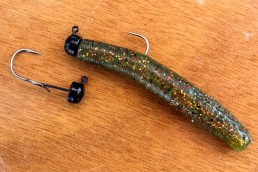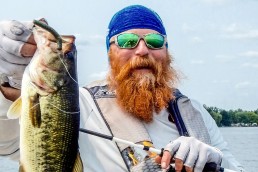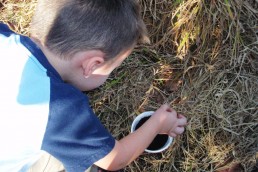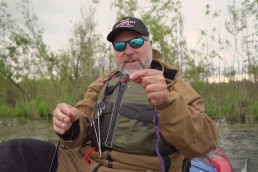Fishing with Ned will Put More Bass on Your Line
SHARE THIS POST
Fall bass fishing just begs for anglers to employ the Ned rig. This is especially true prior to the fall turnover, which normally happens anywhere from September thru November in different parts of the Midwest.
What’s the Ned Rig?
Unless you’ve been living under a rock, you know that the Ned Rig is one of the hottest techniques in bass fishing these days. This ultra-finesse setup was a Midwest secret until a couple of top touring professional bassers brought the Ned Rig into the bass fishing mainstream a half-dozen years ago. Until then, most serious bass anglers laughed at the idea of using “crappie jigs” to target bass. The technique has now proven its worth, racking up multiple tournament wins and helping cash countless checks. Today, you would be hard-pressed to find a tournament bass angler who didn’t have some variation of the Ned Rig on hand.
So, what is the Ned Rig? Like many things in fishing, the exact definition of this rig varies slightly from angler to angler. If you were to ask Ned Kehde (inventor of the rig), he will tell you it refers to a small, soft plastic bait rigged on a light-wire finesse mushroom head jig. That’s a great place to start, but dozens of plastic bait companies, as well as jig makers, produce products which are nearly identical.
Generally speaking, the Ned Rig begins with any small, 2- to 4-inch soft plastic body. Clip the nose off a plastic worm, chop it down to the size you want and thread it on a jig. That’s it. Pick your favorite color.
The bait is almost exclusively thrown on spinning gear and is typically cast out, allowed to fall to the bottom, and then slowly hopped along bottom on the retrieve. This motion mimics either a crawdad skipping along the bottom or a small minnow feeding on the bottom.
While many anglers have picked up on the Ned Rig due to its simple ability to produce bites in tough conditions, many are still not maximizing its effectiveness due to a few simple, easily corrected misconceptions or errors in tackle selection and technique.
Initially, many anglers scoffed at using small, light-wire size 1 and 2 hooks as on the jigheads Ned Kehde used. They thought these small hooks are just too small and not suitable for bass fishing…until they actually tried them. The fact is, anglers will get more bites and maximize the effectiveness of these finesse baits by using a jighead with a small, light-wire hook.
One of the reasons why the Ned Rig works is because of the way a jig with a small hook can allow the bait to stand up off the bottom and move ever-so-slightly with even a tiny bit of current. On the fall, the buoyancy allows for a slower, more horizontal, sometimes spiraling descent. A larger hook can not only weigh down the bait and cause it not to stand up properly, but it can throw off the balance of the rig and cause it look unnatural in the water.
Are you enjoying this post?
You can be among the first to get the latest info on where to go, what to use and how to use it!
By the same token, Ned Rig experts know they need to use the lightest jighead possible. Fish routinely hit the Ned Rig on the fall; when using a heavy jighead, the bait will plummet past the fish, straight to the bottom. A lighter head simply keeps the bait in the strike zone longer and allows for the tantalizing, slow descent that makes the Ned Rig so effective. A lighter head also hangs up less on rocks and helps keep the bait out of grass or algae that lines the bottoms of many lakes.
There are certainly occasions where a heavier 1/6- or 1/5-ounce head is necessary, like in depths of greater than 20 feet or in significant current. Day in and day out, however, a lighter head will simply produce more bites. For general shallow-water lake or pond fishing in depths of 10 feet or less, 1/10-, 1/15-, and 1/20-ounce jigheads should be the mainstay.
Scale down the rod, reel and line if you want to do the Ned Rig right. A light spinning rod is what most Ned-heads prefer, loaded with no more than 10-pound braid. The outfit allows for longer casts with the lightweight lures, and the no-stretch braid will easily set the light-wire hook solidly in Mr. Bass’s mouth.
If you are looking to expand your bass fishing horizons this fall, go fishing with Ned. He’ll put more fish in your boat.
Become a MidWest Outdoors Insider here!
MWO
SHARE THIS POST
Did you enjoy this post?
You can be among the first to get the latest info on where to go, what to use and how to use it!
Mike Schoonveld
A passion for hunting, fishing, trapping and an outdoor lifestyle has been true north on Mike Schoonveld’s compass his whole life. One of the Midwest’s most prolific outdoor communicators, scores of his columns have been published in the pages of MidWest Outdoors since the first one appeared in 1987.



